A dire shortage of water
Parts of the southwestern United States are in the middle of the worst drought in at least 500 years.
By Emily Sohn
If it were up to me, the weather would be hot and sunny every day.
Good thing it’s not up to me. Earth needs rain and snow.
Without a reliable supply of water, we would have nothing to drink, nothing to sustain our crops. Swimming pools would be empty. Lawns would have no grass. Electricity would be expensive. Plants would die; animals would follow.
 |
|
During a drought, wetlands such as this area in Colorado could disappear, threatening the lives of many animals.
|
| Robert Sanders, Ducks Unlimited/U.S. Fish and Wildlife Service |
Such a water shortage may sound extreme, but it’s happening right now in parts of the western United States. An area called the Colorado River Basin, which stretches from Wyoming to Arizona, is in the middle of the worst drought in at least 500 years. Rivers in this region are at their lowest levels ever recorded.
If the drought continues, the results could be disastrous. The river basin is a major source of water for big cities, including Las Vegas, Phoenix, and Los Angeles. Entire ecosystems depend on this water, as do ranchers and many other people who live and work in the area.
Extreme weather
Extreme weather and natural disasters are a normal part of life on Earth. Tornadoes, floods, hurricanes, and earthquakes destroy houses and kill people. Droughts are also menacing. They can last for decades. No one knows how to predict or stop them. In fact, many things that people do make the problem worse.
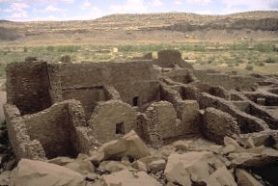 |
|
Ruins at the Chaco Culture National Historical Park in New Mexico.
|
| National Park Service |
Experts say that major droughts in the 1200s and 1300s may have driven the Native American Anasazi out of places such as Mesa Verde in Colorado and Chaco Canyon in New Mexico.
“Water is life,” says geologist John Dohrenwend of Teasdale, Utah. “If you don’t have it, the land can’t support life.”
Out West, rivers and flood plains make up just 3 percent of the land area, Dohrenwend says. But these 3 percent support a full 90 percent of the region’s plant and animal life.
Causes
Scientists are just beginning to understand the conditions that lead to droughts. They’re finding that small changes in the flow of wind and water can have a huge effect on climate around the globe.
Strangely enough, much of the story depends on the temperature of water in the oceans.
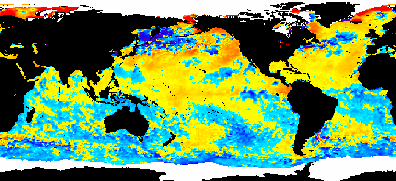 |
|
The colors on this map show where the ocean temperature is above (yellows and reds) or below (blues and violets) normal.
|
| National Oceanic and Atmospheric Administration |
Normally, winds blow west across the tropical Pacific Ocean, away from Central and South America. As wind-driven warm water moves over the ocean, it piles up in Indonesia and elsewhere in the western Pacific. Warm air rises offshore, causing rain to fall. Meanwhile, cold water comes up from the bottom off the coast of South America. This flow allows a richness of life to flourish near the coast, and it helps maintain predictable weather patterns from season to season.
Every 5 to 10 years or so, though, the wind dies down. As a result, the surface of the Pacific Ocean gets warmer. Rainfall then tends to fall further to the east. Such a change in weather causes, among other things, floods in Peru and droughts in Australia and Indonesia. This new weather pattern is known as El Niño.
An opposite cascade of events happens during the weather pattern called La Niña, when Pacific surface temperatures cool down. Both El Niño and La Niña, when they happen, usually last for 2 to 4 years.
The current drought in the West could last much longer than that. In fact, historical records show that droughts typically go on for 10 to 50 years.
And it’s not just El Niño and La Niña at work. In the last few years, scientists from the U.S. Geological Survey (USGS) have begun to link precipitation on the Colorado Plateau to temperature shifts both in the Pacific Ocean and in the Atlantic Ocean.
Atlantic effects
A recent statistical study by USGS researchers found that less moisture falls on the United States when surface temperatures in the North Atlantic are warmer than normal. These conditions prevailed during a number of droughts over the past century.
The study also found a correlation between warm water in the central North Pacific and drought in the southwestern and northern plains of the United States. When water is warm in both the North Atlantic and the North Pacific at the same time, conditions can get mighty dry in the American West.
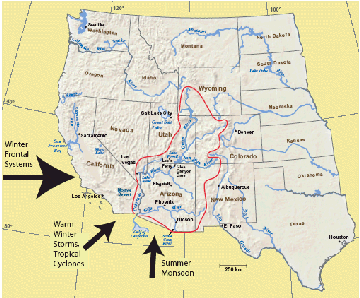 |
|
On this map of the western United States, the Colorado River Basin is outlined in red. The arrows show the direction from which winds typically come at different times of the year.
|
| U.S. Geological Survey |
This explains at least a part of what’s going on right now in the Colorado River Basin, Dohrenwend says.
Records show that the basin’s annual flow volume has been dropping for more than a century. But the drought has grown much worse since the year 2000. Compared to measurements taken in 1922, water flow has dropped to one-third of its original rate.
People problems
Oceans can’t take all of the blame for the impact of today’s drought, Dohrenwend says.
Although ocean temperatures may be an important factor in starting a drought, people are making the problem of water shortages much worse. Dohrenwend notes that cities are growing faster in the southwest than anywhere else in the country. And people keep pouring in.
“Many of these people are retired persons who lived in the northeast or northwest and want to get out of the cold,” Dohrenwend says. It’s hard for them to adjust to using less water than they’re used to, he adds, and they don’t want to let go of their golf courses, green lawns, or long showers.
“Over time, more and more water has to be allocated to people moving in and less goes to everything else,” Dohrenwend says.
Ironically, as the drought continues, the cycle feeds on itself. Ranchers go out of business because they don’t have enough water to grow alfalfa for their cattle. Then, developers arrive and build more homes. As more people move in, the demand for water continues to grow—even as the supply of water rapidly dwindles.
How long?
It’s impossible to know how long this drought will last, and some scientists are beginning to fear the worst.
Dohrenwend, for one, has been monitoring the Lake Powell reservoir, a huge water-storage site in southern Utah. The reservoir provides drinking water to the area. It also feeds into the Glen Canyon Dam, which has huge turbines to generate enormous amounts of electricity.
Right now, water levels in the reservoir are 115 feet below full, Dohrenwend says.
The shallower the lake gets, the more stagnant it becomes. The water has less oxygen in it, and chemicals from agricultural waste become more concentrated. Eventually, the water would become too toxic to drink.
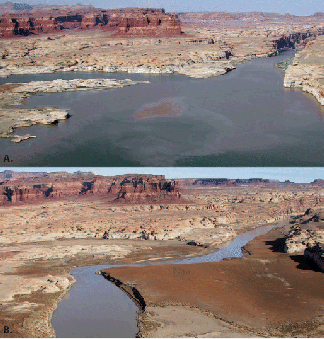 |
|
Water levels in Utah’s Lake Powell have fallen more than 30 feet between June 2002 (top) and December 2003 (bottom).
|
| John Dohrenwend |
Dohrenwend has been using photographs and measurements to document the movement of sediment through rivers toward the Lake Powell reservoir. Ever since the drought began, his research shows, piles of dirt, rock, and sand have been moving downstream at an alarming rate.
If the sediment gets too close to the dam’s turbines, Dohrenwend says, it could ruin them completely. “The turbines rotate extremely rapidly,” he says. “It would take very little sediment to destroy the turbines. With any abrasive material, it wouldn’t take any time at all.”
In any case, the water level could soon be so low that it won’t even flow through the dam anymore. This would cut off the electricity supply altogether. Downstream, the Grand Canyon could dry up.
Impact
As scientists continue to study what causes droughts and what kind of impact they can have, it’ll be essential for governments and citizens to change their behavior, Dohrenwend says.
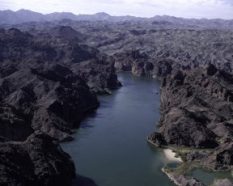 |
|
Along the banks of the Colorado River, the Havasu National Wildlife Refuge attracts more than 500,000 visitors a year, many of whom are interested in water recreation. The refuge is also the home for nearly 300 species of birds, including herons, pelicans, grebes, and woodpeckers. |
| Jim Rorabaugh, U.S. Fish and Wildlife Service |
If people want to continue living with cheap electricity and clean water, they’ll need to find ways to use less of the precious liquid. In fact, the drought in the West might just be a wakeup call for all of us, no matter where we live.
“In some ways, the problem sounds like a simple one of not enough water,” Dohrenwend says. But it’s really more complicated than that.
“When you start to look at what goes on in a river flowing from the mountains to the sea, all the things we as human beings use it for, and all of what actually happens during a drought, a lot of what is going to happen isn’t necessarily obvious,” he says. “It could cause things we don’t want to happen to happen much sooner than we might think.”
Going Deeper:
Drought Facts
- The annual flow volume of the upper Colorado River from 2001 to 2003 averaged 6.66 cubic kilometers, barely half the average flow there during the Dust Bowl years, between 1930 and 1937.
- From analyses of tree rings, USGS scientists infer that the average flow rate of the upper Colorado River between 1590 and 1594—previously the worst drought in the past half millennium—was about 25 percent higher than that measured between 1999 and 2003.
Comments:
I really like this article because it simply tells how important water is
and how no more water affects us and Earth. It would be great to have a
few sunny days, but not all the time.—Ericka, 11







